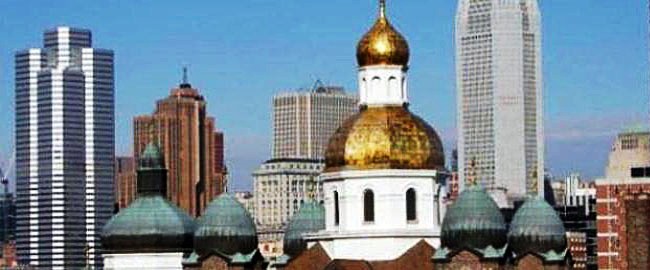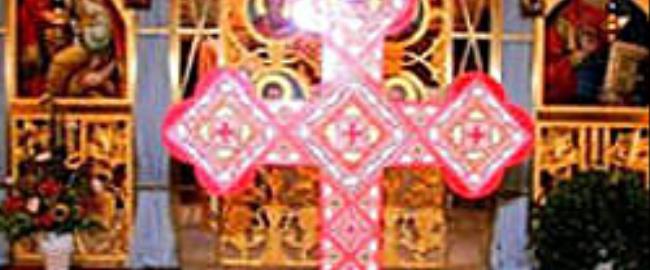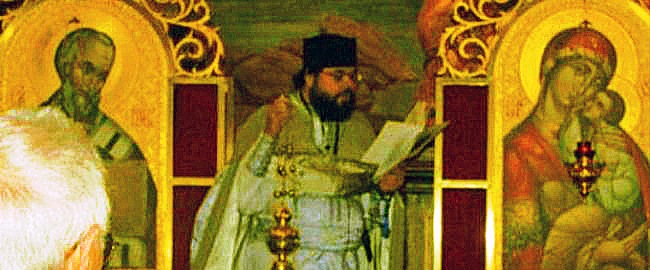Although we have our own Patriarch and Bishops,
we are Catholics in union with the “Pope of Rome”, who is also
simultaneously the Head of the Western Church and the “Bishop of Rome”.
By virtue of the Communion of our Patriarch and Church in Kyiv-Ukraine with
the Head and Church in Rome, we are a Catholic Church, sharing in the same
belief, faith and
![]() sacraments
as all Catholic peoples. Thus, all Catholics who liturgize (attend
Vesperal Liturgy or Matinal Liturgy or Divine Liturgyn or the Typika
Liturgy) with us, fulfill their Holy-day and Sunday obligations, as
attendance at Mass would do in their own churches. Being Eastern
Catholics, we have an equally apostolic approach to theology, spirituality,
church law and liturgical tradition, as do Western Catholics. However,
most people’s first exposure to us occurs when they witness our
repetitive, timeless, and non-rational way of Liturgy (celebrating and
expressing our Catholic Faith), geared towards effecting the subconscious.
This is where our Eastern-Byzantine customs and traditions are most
conspicuous to a Western, or non-Christian.
sacraments
as all Catholic peoples. Thus, all Catholics who liturgize (attend
Vesperal Liturgy or Matinal Liturgy or Divine Liturgyn or the Typika
Liturgy) with us, fulfill their Holy-day and Sunday obligations, as
attendance at Mass would do in their own churches. Being Eastern
Catholics, we have an equally apostolic approach to theology, spirituality,
church law and liturgical tradition, as do Western Catholics. However,
most people’s first exposure to us occurs when they witness our
repetitive, timeless, and non-rational way of Liturgy (celebrating and
expressing our Catholic Faith), geared towards effecting the subconscious.
This is where our Eastern-Byzantine customs and traditions are most
conspicuous to a Western, or non-Christian.
At the Last Supper, which we call the “Mystical Supper”, after Jesus changed bread and wine into His own true Body and true Blood, He told His disciples to, “Do this in memory of Me.” This they did. As the disciples brought the Gospel to different parts of the world, they adapted ceremonies of the Divine Liturgy to the customs and music of that people. In the end, four great Centers of Christianity emerged with distinctive Christian customs, but the same Faith. One Center was Western, located in the great city of Rome. Three Centers were Eastern, located in the great cities of Jerusalem, Antioch and Alexandria. A couple of centuries later, when the capital of the Roman Empire was moved to the Eastern city of Byzantium, renamed Constantinople, an adaptation of the Antioch way of celebrating liturgy was made. Thus, a new Eastern Center of Christianity arose in Constantinople and became known as the Byzantine Church. This Church’s missionary work especially that of Sts. Cyril and Methodius, began to reach out to the Slavic peoples of Eastern Europe. Various rulers of state, who were often canonized as “enlighteners” or “equal’s-of-the-apostles” collaborated with the clergy. For example, the Church of Kyiv-Ukraine, and her Daughter Churches (such as the Church in Russia), commemorate Saints Volodimir and Olha, as such. For many historical, political, social and economic reasons, and some theological ones as well, not all of the Eastern Christians were able to maintain an uninterrupted Communion with the Church in Rome, when she and the Church in Constantinople progressively took steps to break communion with one another, during 1054-1204.
Although each of the Eastern Churches has a history all its own, those who are in Communion with the Church in Constantinople are generally referred to as “Eastern, Russian or Greek Orthodox”. Meanwhile, those who never lost, or renewed, their Communion with the Church in Rome are generally referred to as “Eastern Catholics”. The majority of these follow Byzantine theology, spirituality, liturgy and church law. But not all of the Eastern Catholics are “Byzantine”. (Other names include the Austro-Hungarian term “Greco-Catholics”, which is still used occasionally; however, the term “Uniate” is pejorative and should be avoided). Furthermore, both Eastern Orthodox and Eastern Catholics are comprised of ecclesiastical jurisdictions arising from their ethnic or geographic points of origin, for example: Abyssinian (Ethiopian), Albanian, Armenian, Belarusian, Bulgarian, Chaldean (Iraqi), Coptic (Egyptian), Croatian, Georgian, Greek, Hungarian, Italo-Albanian, Japanese, Malankarese (Indian), Maronite (Lebanese), Melkite, Romanian, Russian, Ruthenian (Sub-Carpathian), Serbian, Slovak, Syrian, Syro-Malabarese (Indian), Ukrainian, etc. When these people migrated to the United States, they brought their treasure of Faith, as it was incarnated in their persecuted homelands.
It was vital that they be able to communicate not in the language of foreign invaders, but in the language reserved for those who are near and dear, first of whom is God. Nevertheless, a valid concern and tension arises if one is mindful that to be Catholic (Universal), by definition, means to be open to people of all ethnic backgrounds and races. Thus, even as we respect our original languages and cultures, Eastern Catholics strive to welcome anyone whom our Lord, God and Savior, Jesus Christ, wishes to add to our family. We do not mistake uniformity for unity; for, we believe that our ability to accept one another lovingly is what reveals our real Catholicity. We believe that East and West were (and can again be) complementary, rather than contradictory. So, it follows that the entire Catholic Church, be it Eastern or Western, is the heir to a Faith in God, one in the Holy Trinity: Father, Son and Holy Spirit. This is essential in our journey to God. It is both traditional and modern, and emphasizes that through our union with Christ, we become God-like and His beloved children.
We believe that God is with us and that in Holy Communion we receive the Body and Blood of Christ, the Son of God, by the power of the Holy Spirit.Our St John the Baptist Parish belongs to the St. Josaphat Eparchy (Diocese) in Parma, Ohio. Along with our eparchies in Chicago, IL and Stamford, CT, we are part of the Archeparchy (Archdiocese) of Philadelphia, PA; together these four are an integral part of the world-wide Kyivan (Ukrainian) Catholic Church, with its Patriarch and Synod of Bishops, in Kyiv-Ukraine, which is in union with the Pope of Rome, supreme pastor of the universal Church.






